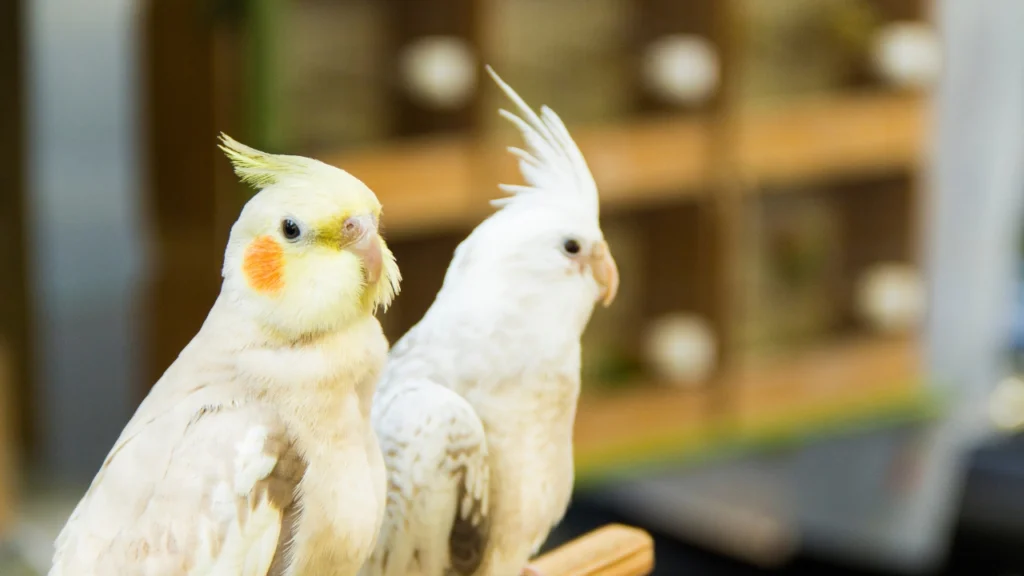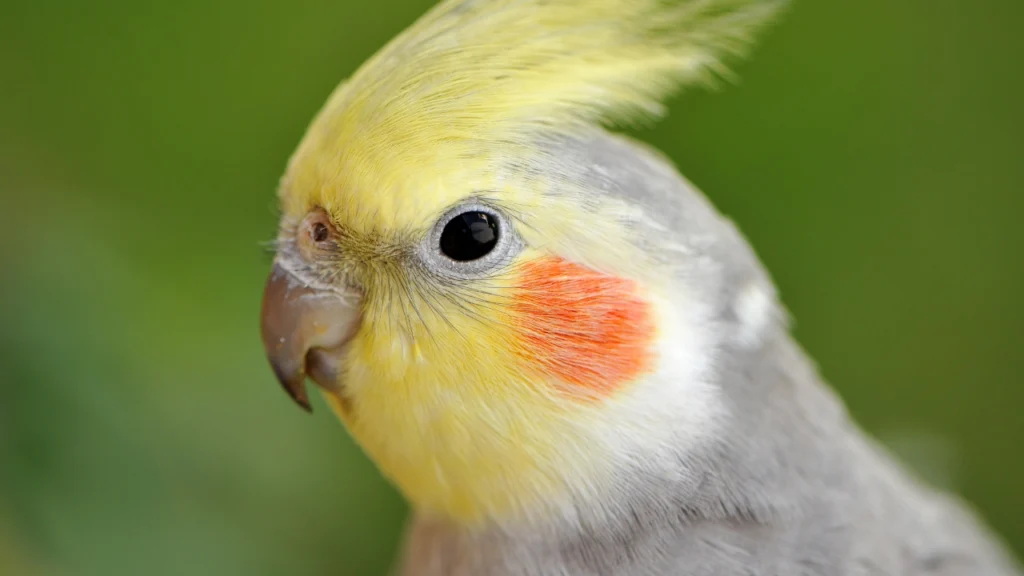Introduction to Cockatiels as Pets
Cockatiels, known for their charming personalities and gentle disposition, are popular companion birds around the world. Their endearing traits make them an ideal choice for both novice and experienced bird owners.
A. Overview of Cockatiels

Cockatiels (Nymphicus hollandicus) are medium-sized members of the parrot family originating from Australia. Their distinguishing features include a prominent crest on their head, vibrant colorations, and a long, elegant tail. They are prized for their friendly nature and adaptability to human interaction.
B. Appeal as Companion Birds
What makes cockatiels exceptional as pets is their amiable temperament and social nature. They are known for their ability to form strong bonds with their owners and thrive on companionship. Their gentle demeanor and playful antics make them delightful additions to households seeking feathered companionship.
Cockatiels have a moderate noise level compared to some larger parrot species, making them suitable for apartment living or quieter environments. Their relatively small size and charming personalities make them an excellent choice for individuals or families looking for a loving avian companion.
Understanding Cockatiel Species
Cockatiels exhibit a fascinating array of characteristics and behaviors that contribute to their appeal as pets.
A. Description and Characteristics
Cockatiels typically showcase a soft, grey body color with striking accents such as vibrant orange cheek patches and a prominent, expressive crest atop their heads. They also exhibit variations in color mutations, offering a wide spectrum of hues in captivity, including lutino, pied, pearl, and cinnamon.
Their charming disposition is complemented by their friendly and curious nature, making them highly approachable and adaptable to human interaction. Cockatiels are generally known for their gentle demeanor, making them well-suited for households with various family members.
B. Varieties and Colors

These engaging birds come in various color mutations, appealing to enthusiasts who appreciate their diverse aesthetics. Breeders have developed different color variations over the years, resulting in a wide range of plumage patterns and shades, each displaying its unique beauty.
Cockatiels also exhibit distinct characteristics based on gender, with males often showcasing brighter cheek patches and females generally bearing horizontal stripes on the underside of their tail feathers.
C. Native Habitat and Behavior
Originally from the arid regions of Australia, cockatiels are social creatures that often inhabit scrublands, open forests, and grasslands. They are naturally communal birds, often found in flocks, displaying their sociable nature by preening each other and engaging in interactive behaviors.
Their inquisitive and playful behavior in the wild translates well into captivity, making them highly adaptable and amenable to various interactive activities and toys in a home environment.
Benefits of Keeping Cockatiels as Pets
Owning a cockatiel comes with a multitude of rewarding benefits owing to their delightful traits and engaging personalities.
A. Affectionate and Social Nature
Cockatiels are renowned for their affectionate and sociable demeanor. They readily bond with their human companions, displaying their love through gentle head bobs, snuggling against fingers, and even mimicking human behaviors to seek attention. Their ability to form strong, lasting bonds makes them cherished companions.
B. Vocal Abilities and Sounds
While not as proficient at talking as some larger parrot species, cockatiels possess impressive vocal abilities. They are skilled whistlers and can mimic sounds, including melodies and household noises. Their cheerful chirping and melodious tunes often brighten the atmosphere, adding a pleasant ambiance to a home.
C. Intelligence and Trainability
Despite their small size, cockatiels exhibit remarkable intelligence and can learn tricks and behaviors through positive reinforcement training. They readily respond to training sessions involving simple commands, offering mental stimulation and strengthening the bond between the bird and its owner.
Their intelligence, coupled with their friendly disposition, makes them amiable learners, allowing for enjoyable training sessions that benefit both the bird and the owner.
Preparations before having Cockatiels as Pets
Before bringing a cockatiel into your home, it’s essential to create a suitable environment to ensure their well-being and happiness.

A. Cage Setup and Environmental Needs
Select a spacious cage with horizontal space for flying and vertical room for climbing. Ensure the bars are appropriately spaced to prevent escape or injury. Equip the cage with perches of varying diameters and textures to promote foot health. Additionally, provide toys for mental stimulation and activities to prevent boredom.
B. Diet and Nutrition Requirements
A well-balanced diet is vital for the health of your pet cockatiel. Offer a mix of high-quality pellets, fresh vegetables, fruits, and occasional treats. Ensure a constant supply of clean, fresh water and monitor their eating habits to maintain their nutritional needs.
C. Toys and Enrichment Activities
Cockatiels are inquisitive birds that require mental stimulation. Provide a variety of toys like bells, ropes, puzzles, and chewable items to prevent boredom. Regularly rotate toys to keep them engaged and introduce new ones periodically to maintain their interest.
Creating an enriching environment with appropriate cage setup, a balanced diet, and engaging toys sets the stage for a healthy and contented pet cockatiel.
Training and Bonding for Cockatiels as Pets
Establishing a strong bond and fostering a trusting relationship with your cockatiel is pivotal for their well-being and your mutual enjoyment.
A. Establishing Trust and Bonding
Spend quality time near your cockatiel’s cage to allow them to become accustomed to your presence. Offer treats, speak softly, and make gentle movements to build trust gradually. Allow them to approach you at their own pace, avoiding sudden or forceful interactions.
B. Basic Training Techniques
Begin with basic training exercises such as step-up commands, target training, or simple tricks using positive reinforcement methods. Use treats, praise, and patience to encourage desired behaviors. Consistency and short, frequent training sessions are key to successful training.
C. Socialization and Playtime
Regularly interact with your cockatiel outside the cage in a safe and supervised area. Offer opportunities for flight and exploration while ensuring a secure environment. Engage in interactive play sessions to strengthen your bond and provide mental stimulation.
By dedicating time to training, gentle interactions, and supervised play, you’ll establish a strong bond with your cockatiel, enhancing their trust and fostering a rewarding relationship.
Health and Care for Cockatiels as Pets
Maintaining the health and well-being of your pet cockatiel is paramount for their longevity and happiness.

A. Signs of a Healthy Cockatiel
Monitoring your cockatiel’s health involves observing their behavior, appearance, and eating habits. A healthy cockatiel typically displays bright eyes, sleek feathers, active behavior, and a good appetite. Regularly check for any signs of illness, such as changes in droppings, unusual feather plucking, or decreased activity.
B. Common Health Issues and Prevention
Cockatiels can be susceptible to health problems like respiratory issues, nutritional deficiencies, and feather disorders. To prevent these issues, provide a balanced diet, a clean living environment, regular exercise, and routine veterinary check-ups. Ensure they have adequate space and avoid exposure to drafts or sudden temperature changes.
C. Veterinary Care and Check-ups
Schedule regular visits to an avian veterinarian for health check-ups and advice on nutrition, vaccinations, and parasite control. Address any health concerns promptly to prevent the progression of illnesses and ensure your cockatiel’s well-being.
Regular veterinary care, a nutritious diet, and a vigilant eye on your cockatiel’s health are crucial for their overall health and happiness.
Cockatiel Behavior and Communication
Understanding cockatiel behavior and communication is essential for interpreting their needs and strengthening your bond with them.
A. Understanding Cockatiel Body Language
Cockatiels communicate through body language cues. Raised crests, relaxed feathers, and bright eyes signify a content and comfortable bird. On the contrary, flattened crests, hissing, or aggressive postures indicate fear or discomfort. Observing their body language helps in understanding their emotional state.
B. Vocalizations and Expressions
Cockatiels are expressive vocalizers, using chirps, whistles, and specific sounds to communicate. While not as adept at mimicry as larger parrot species, they can learn tunes or whistle back in response to their owners. Understanding their vocalizations aids in deciphering their mood or preferences.
C. Building Communication and Trust
Building trust with your cockatiel involves consistent, gentle interactions and respecting their boundaries. Engage in conversations, sing, or whistle softly to establish a line of communication. Over time, your cockatiel will respond positively to your voice and gestures, strengthening your bond.
Understanding and responding to your cockatiel’s body language and vocalizations help in establishing effective communication and a deeper connection.
Frequently Asked Questions (FAQs) about Cockatiels as Pets
Are cockatiels good pets?
Yes, cockatiels make excellent pets for various reasons. They’re known for their friendly and social nature, making them great companions. Cockatiels are also relatively easy to care for, adaptable to different environments, and can form strong bonds with their owners, showcasing affection and loyalty. Their charming personalities and ability to learn simple tricks contribute to their appeal as wonderful pets for both individuals and families.
Is it good to keep cockatiel at home?
Yes, keeping a cockatiel at home can be a wonderful experience. Cockatiels are known for their friendly and adaptable nature, making them suitable pets for households. They are relatively small in size compared to some other parrot species, making them suitable for indoor living. With proper care, attention, and a suitable environment, cockatiels can thrive as happy and contented pets in a home setting, providing companionship and joy to their owners.
Are cockatiels good for beginners?
Yes, cockatiels are often recommended for beginners in the world of bird ownership. They are generally considered more forgiving in terms of care requirements compared to larger parrot species. Their friendly demeanor, relatively easygoing nature, and ability to form strong bonds make them a good choice for novice bird owners. However, like any pet, they still require proper care, attention, and commitment from their owners to thrive in their environment.
Which is better budgie or cockatiel?
Choosing between a budgie (Budgerigar) and a cockatiel depends on individual preferences and lifestyle. Both birds have unique traits. Budgies are smaller, generally less expensive, and can be easier to care for due to their size. Cockatiels, while slightly larger, are known for their sociable nature, intelligence, and ability to mimic sounds. Cockatiels may be more interactive and tend to bond strongly with their owners. The choice between the two would depend on factors like desired size, personality, and level of interaction wanted from a pet bird.
What do cockatiels eat?
Cockatiels have diverse dietary needs. A balanced diet for a pet cockatiel typically includes high-quality pellets, supplemented with fresh vegetables such as carrots, leafy greens like kale or spinach, and occasional fruits like apples or berries. They also enjoy seeds but these should be offered in moderation due to their high-fat content. Providing clean, fresh water is essential for their hydration. Offering a varied diet ensures they receive essential nutrients for their overall health and well-being.
How long cockatiels live?
Cockatiels have a relatively long lifespan compared to many other pet birds. On average, they can live between 15 to 25 years or even longer with proper care, a healthy diet, and a suitable living environment. Some cockatiels have been known to live up to 30 years or more, emphasizing the importance of commitment and providing lifelong care for these cherished companions.
What do cockatiels eat?
Cockatiels have diverse dietary needs. A balanced diet for a pet cockatiel typically includes high-quality pellets, supplemented with fresh vegetables such as carrots, leafy greens like kale or spinach, and occasional fruits like apples or berries. They also enjoy seeds but these should be offered in moderation due to their high-fat content. Providing clean, fresh water is essential for their hydration. Offering a varied diet ensures they receive essential nutrients for their overall health and well-being.
Do cockatiels talk?
Cockatiels are not known for their extensive talking abilities like some larger parrot species such as African Greys or Amazons. However, they are skilled in mimicry and can learn to whistle tunes, songs, and simple words or phrases. While not all cockatiels talk, some individuals may surprise their owners by picking up and repeating sounds or words with patience and consistent training.
How long do cockatiels live as pets?
Cockatiels, when kept as pets and provided with proper care, can live between 15 to 25 years on average. With a nurturing environment, a balanced diet, regular exercise, and routine veterinary care, some cockatiels may even surpass this average lifespan and live for 30 years or more, bringing long-lasting companionship to their owners.
Can cockatiels talk or mimic sounds?
Yes, cockatiels are capable of mimicking sounds and can learn to imitate whistles, tunes, and sometimes simple words or phrases. While they might not possess the extensive vocabulary of larger parrot species, some cockatiels can surprise their owners by mimicking various sounds with patience, consistent training, and social interaction.
How do you tame a cockatiel?
Taming a cockatiel requires patience, consistency, and gentle interaction. Here are steps to help in the taming process:
Create a Calm Environment: Start by placing the cockatiel’s cage in a quiet area where they can observe daily activities.
Gradual Interaction: Spend time near the cage, talking softly, and offering treats to establish trust. Allow the bird to become comfortable with your presence.
Slow Approach: Once the bird seems receptive, slowly offer your hand or a perch for them to step onto. Move slowly and avoid sudden movements.
Positive Reinforcement: Reward calm and positive behaviors with treats or praise. Slowly increase interaction, allowing the bird to get used to being handled.
Consistent Training: Practice short, frequent training sessions to encourage step-up commands or other simple behaviors. Use treats and patience to reinforce positive actions.
Building Trust: Over time, as the cockatiel becomes more comfortable, continue to build trust through gentle handling and positive interactions.
Remember, each cockatiel is unique, and the taming process may vary. It’s crucial to respect their pace and never force interactions, allowing the bird to gradually develop trust and comfort with you.
Conclusion: Recap of Key Points about Cockatiels as Pets
Cockatiels, with their charming demeanor and interactive nature, make delightful companions for bird enthusiasts. Their engaging personalities, coupled with their ability to form strong bonds, contribute to their appeal as household pets. Understanding their needs and behaviors is essential for providing them with a nurturing environment.
From the overview of their species to insights into their behaviors, diet, health care, and bonding techniques, this guide aims to equip potential owners who have cockatiels as pets with essential information for responsible and enjoyable pet ownership.
Understanding the significance of a well-prepared environment, training methods, and the importance of regular veterinary care are integral aspects of ensuring the well-being of pet cockatiels. Building a loving relationship with these feathered companions involves patience, dedication, and mutual respect.
By fostering trust through gentle interactions, training sessions, and understanding their communication cues, you can establish a strong bond with your cockatiel, making the companionship a fulfilling and rewarding experience.

